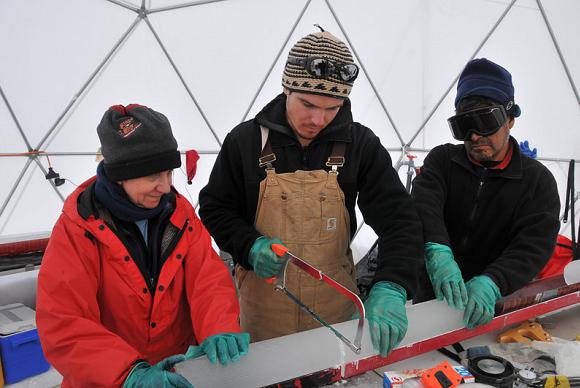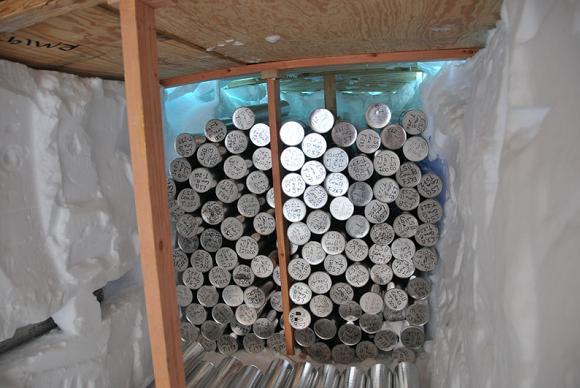Original URL: https://www.theregister.com/2010/04/13/antarctic_boffins_record_ice_core/
Antarctic boffins obtain prehistoric deep ice core sample
Expedition returns from isolated, stormbound camp
Posted in Science, 13th April 2010 11:09 GMT
A team of boffins who have been mounting difficult deep drilling operations at a remote camp in Antarctica believe they may have obtained ice cores dating from the last glacial era.
"My gut feeling is that the ice at the Bruce Plateau site might have built up during the latter part of the last glacial stage," says Ellen Mosley-Thompson, top boffin on the project.

Damn, I've lost count.
Mosley-Thompson and her international team of specialists were funded by the US National Science Foundation, as part of the larger Larsen Ice Shelf System, Antarctica (LARISSA) project. LARISSA is aimed at discovering the reason why large bits of the projecting Larsen ice shelf broke up in 2002.
One theory is that the Larsen breakup results from human-driven global warming, but there are other explanations. German and Russian scientists, for instance, have suggested lately that interglacial periods like the present Holocene - which is probably ending - may finish with one or more brief warming periods before the glaciers return.
Other scientists have theorised that climate conditions around the Larsen shelf are a highly unusual case, very different from the rest of Antarctica. It's a little-known fact that the area of Antarctic sea ice has actually increased overall by nearly 40,000 square miles per decade over the last 30 years: the Larsen sheet breakup may simply be a minor anomaly.
Earlier LARISSA surveys using ground-penetrating radar had suggested that the Bruce Plateau would be a good place to obtain ice cores illustrating the entire history of the Larsen shelf, right back perhaps to the last glacial era, millennia ago before the present Holocene warm time began.
Accordingly, Mosley-Thompson and five other boffins flew out to the Plateau from the British research station Rothera (on the western Antarctic peninsula) last December. They set up a small camp including a geodesic dome covering a special ice-drilling rig, intended to obtain ice cores all the way down to the polar bedrock. Operations commenced on New Year's Eve.
But the drilling didn't go smoothly.
'The expedition FROM HELL'
"It was the field season from hell," says Mosley-Thompson, professor of geography at Ohio State University and leader of the project. "Everything that could go wrong did, and almost everything that could break did."

There were severe penalties for stealing cores to cool drinks.
One drill became stuck in the ice at a depth of 140m; a second, drilling a new hole, locked up at 383m. The boffins managed to modify a piece of kit intended to remove water from the drill hole to squirt antifreeze down it instead, freeing up the drill, but their problems weren't over. A drill motor broke and all three of the gearboxes brought with the expedition failed, forcing swearing scientists to build a new one out of parts salvaged from the wrecks. Supply and support flights had to be cancelled due to bad weather at the site.
"The guys on our team, Victor Zagorodnov and Vladimir Mikhalenko, engineered through each problem that arose and were really very creative," explains Mosley-Thompson.
The plucky boffins won through in the end, finally punching through to the underlying rock 445.6m below the drill rig after 28 days' gruelling effort. The resulting, record-breaking ice core was sawn up into 1m lengths and initially stored in snow trenches at the camp.
As weather permitted, the cores were flown out to the Rothera station and stashed in freezers. They will be picked up from there by a US research ship and are expected to reach America for analysis this (northern-hemisphere) summer.
Mosley-Thompson and her colleagues are hoping that their core - perhaps jointly with another 363m one drilled in 2007 by the British Antarctic Survey - will unravel the entire history of the Larsen shelf right back to the last ice age. This could help to answer the tricky question of why the Larsen shelf is behaving differently from the rest of Antarctica, and shedding ice rather than gaining it as is happening elsewhere.
Analysis of the two cores, yet to be completed, should offer some interesting insights. ®